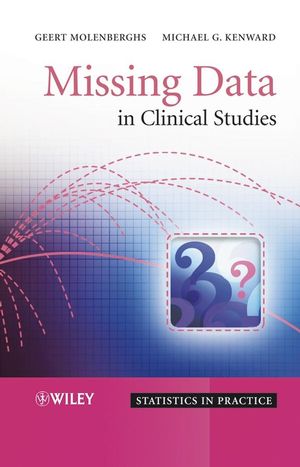Missing Data in Clinical StudiesISBN: 978-0-470-84981-1
Hardcover
536 pages
March 2007
 Other Available Formats: E-book
|
||||||
Acknowledgements.
I Preliminaries.
1 Introduction.
1.1 From Imbalance to the Field of Missing Data Research.
1.2 Incomplete Data in Clinical Studies.
1.3 MAR, MNAR, and Sensitivity Analysis.
1.4 Outline of the Book.
2 Key Examples.
2.1 Introduction.
2.2 The Vorozole Study.
2.3 The Orthodontic Growth Data.
2.4 Mastitis in Dairy Cattle.
2.5 The Depression Trials.
2.6 The Fluvoxamine Trial.
2.7 The Toenail Data.
2.8 Age-Related Macular Degeneration Trial.
2.9 The Analgesic Trial.
2.10 The Slovenian Public Opinion Survey.
3 Terminology and Framework.
3.1 Modelling Incompleteness.
3.2 Terminology.
3.3 Missing Data Frameworks.
3.4 Missing Data Mechanisms.
3.5 Ignorability.
3.6 Pattern-Mixture Models.
II Classical Techniques and the Need for Modelling.
4 A Perspective on Simple Methods.
4.1 Introduction.
4.2 Simple Methods.
4.3 Problems with Complete Case Analysis and Last Observation Carried Forward.
4.4 Using the Available Cases: a Frequentist versus a Likelihood Perspective.
4.5 Intention to Treat.
4.6 Concluding Remarks.
5 Analysis of the Orthodontic Growth Data.
5.1 Introduction and Models.
5.2 The Original, Complete Data.
5.3 Direct Likelihood.
5.4 Comparison of Analyses.
5.5 Example SAS Code for Multivariate Linear Models.
5.6 Comparative Power under Different Covariance Structures.
5.7 Concluding Remarks.
6 Analysis of the Depression Trials.
6.1 View 1: Longitudinal Analysis.
6.2 Views 2a and 2b and All versus Two Treatment Arms.
III Missing at Random and Ignorability.
7 The Direct Likelihood Method.
7.1 Introduction.
7.2 Ignorable Analyses in Practice.
7.3 The Linear Mixed Model.
7.4 Analysis of the Toenail Data.
7.5 The Generalized Linear Mixed Model.
7.6 The Depression Trials.
7.7 The Analgesic Trial.
8 The Expectation–Maximization Algorithm.
8.1 Introduction.
8.2 The Algorithm.
8.3 Missing Information.
8.4 Rate of Convergence.
8.5 EM Acceleration.
8.6 Calculation of Precision Estimates.
8.7 A Simple Illustration.
8.8 Concluding Remarks.
9 Multiple Imputation.
9.1 Introduction.
9.2 The Basic Procedure.
9.3 Theoretical Justification.
9.4 Inference under Multiple Imputation.
9.5 Efficiency.
9.6 Making Proper Imputations.
9.7 Some Roles for Multiple Imputation.
9.8 Concluding Remarks.
10 Weighted Estimating Equations.
10.1 Introduction.
10.2 Inverse Probability Weighting.
10.3 Generalized Estimating Equations for Marginal Models.
10.4 Weighted Generalized Estimating Equations.
10.5 The Depression Trials.
10.6 The Analgesic Trial.
10.7 Double Robustness.
10.8 Concluding Remarks.
11 Combining GEE and MI.
11.1 Introduction.
11.2 Data Generation and Fitting.
11.3 MI-GEE and MI-Transition.
11.4 An Asymptotic Simulation Study.
11.5 Concluding Remarks.
12 Likelihood-Based Frequentist Inference.
12.1 Introduction.
12.2 Information and Sampling Distributions.
12.3 Bivariate Normal Data.
12.4 Bivariate Binary Data.
12.5 Implications for Standard Software.
12.6 Analysis of the Fluvoxamine Trial.
12.7 The Muscatine Coronary Risk Factor Study.
12.8 The Crépeau Data.
12.9 Concluding Remarks.
13 Analysis of the Age-Related Macular Degeneration Trial.
13.1 Introduction.
13.2 Direct Likelihood Analysis of the Continuous Outcome.
13.3 Weighted Generalized Estimating Equations.
13.4 Direct Likelihood Analysis of the Binary Outcome.
13.5 Multiple Imputation.
13.6 Concluding Remarks.
14 Incomplete Data and SAS.
14.1 Introduction.
14.2 Complete Case Analysis.
14.3 Last Observation Carried Forward.
14.4 Direct Likelihood.
14.5 Weighted Estimating Equations.
14.6 Multiple Imputation.
IV Missing Not at Random.
15 Selection Models.
15.1 Introduction.
15.2 The Diggle–Kenward Model for Continuous Outcomes.
15.3 Illustration and SAS Implementation.
15.4 An MNAR Dale Model.
15.5 A Model for Non-monotone Missingness.
15.6 Concluding Remarks.
16 Pattern-Mixture Models.
16.1 Introduction.
16.2 A Simple Gaussian Illustration.
16.3 A Paradox.
16.4 Strategies to Fit Pattern-Mixture Models.
16.5 Applying Identifying Restrictions.
16.6 Pattern-Mixture Analysis of the Vorozole Study.
16.7 A Clinical Trial in Alzheimer’s Disease.
16.8 Analysis of the Fluvoxamine Trial.
16.9 Concluding Remarks.
17 Shared-Parameter Models.
18 Protective Estimation.
18.1 Introduction.
18.2 Brown’s Protective Estimator for Gaussian Data.
18.3 A Protective Estimator for Categorical Data.
18.4 A Protective Estimator for Gaussian Data.
18.5 Concluding Remarks.
V Sensitivity Analysis.
19 MNAR, MAR, and the Nature of Sensitivity.
19.1 Introduction.
19.2 Every MNAR Model Has an MAR Bodyguard.
19.3 The General Case of Incomplete Contingency Tables.
19.4 The Slovenian Public Opinion Survey.
19.5 Implications for Formal and Informal Model Selection.
19.6 Behaviour of the Likelihood Ratio Test for MAR versus MNAR.
19.7 Concluding Remarks.
20 Sensitivity Happens.
20.1 Introduction.
20.2 A Range of MNAR Models.
20.3 Identifiability Problems.
20.4 Analysis of the Fluvoxamine Trial.
20.5 Concluding Remarks.
21 Regions of Ignorance and Uncertainty.
21.1 Introduction.
21.2 Prevalence of HIV in Kenya.
21.3 Uncertainty and Sensitivity.
21.4 Models for Monotone Patterns.
21.5 Models for Non-monotone Patterns.
21.6 Formalizing Ignorance and Uncertainty.
21.7 Analysis of the Fluvoxamine Trial.
21.8 Artificial Examples.
21.9 The Slovenian Public Opinion Survey.
21.10 Some Theoretical Considerations.
21.11 Concluding Remarks.
22 Local and Global Influence Methods.
22.1 Introduction.
22.2 Gaussian Outcomes.
22.3 Mastitis in Dairy Cattle.
22.4 Alternative Local Influence Approaches.
22.5 The Milk Protein Content Trial.
22.6 Analysis of the Depression Trials.
22.7 A Local Influence Approach for Ordinal Data with Dropout.
22.8 Analysis of the Fluvoxamine Data.
22.9 A Local Influence Approach for Incomplete Binary Data.
22.10 Analysis of the Fluvoxamine Data.
22.11 Concluding Remarks.
23 The Nature of Local Influence.
23.1 Introduction.
23.2 The Rats Data.
23.3 Analysis and Sensitivity Analysis of the Rats Data.
23.4 Local Influence Methods and Their Behaviour.
23.5 Concluding Remarks.
24 A Latent-Class Mixture Model for Incomplete Longitudinal Gaussian Data.
24.1 Introduction.
24.2 Latent-Class Mixture Models.
24.3 The Likelihood Function and Estimation.
24.4 Classification.
24.5 Simulation Study.
24.6 Analysis of the Depression Trials.
24.7 Concluding Remarks.
VI Case Studies.
25 The Age-Related Macular Degeneration Trial.
25.1 Selection Models and Local Influence.
25.2 Local Influence Analysis.
25.3 Pattern-Mixture Models.
25.4 Concluding Remarks.
26 The Vorozole Study.
26.1 Introduction.
26.2 Exploring the Vorozole Data.
26.3 A Selection Model for the Vorozole Study.
26.4 A Pattern-Mixture Model for the Vorozole Study.
26.5 Concluding Remarks.
References.
Index.



